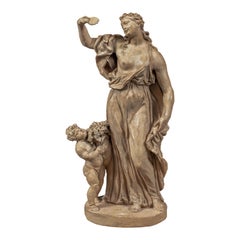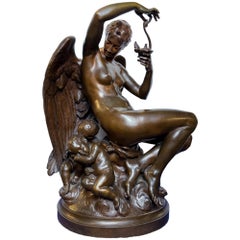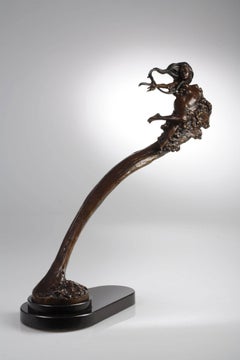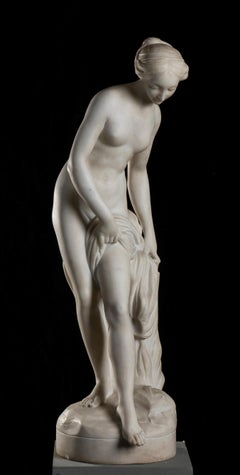Rococo Nude Sculptures
to
1
1
Overall Width
to
Overall Height
to
1
1
1
463
81
63
17
17
8
7
7
6
2
2
2
1
2
1
1
1
1
1
1
1
1
1
1
1
1
1
1
Style: Rococo
Rococò Italian artist - 18th century terracotta figure sculpture - Allegory
Located in Varmo, IT
Terracotta sculpture - Allegory of Vanity. Italy, 18th century.
17 x 12 x 42 cm high.
Made entirely of terracotta. It depicts a bare-breasted girl holding a mirror and a cherub wit...
Category
Mid-18th Century Rococo Nude Sculptures
Materials
Terracotta
Bronze Female Statue "Le Crépuscule" by Emile Andre Boisseau
Located in New York, NY
Emile-Andre Boisseau (French, 1842-1923)
Le Crépuscule
signed 'E. Boisseau' (on the base)
Bronze
height: 29 in. (74 cm.)
Emile-André Boisseau was a...
Category
19th Century Rococo Nude Sculptures
Materials
Bronze
Related Items
Model Girl
Located in Zofingen, AG
Classic female torso inspired by examples of high Greek sculpture. Sculptor explores the lines and shapes of the female body, embodied the diversity, slightly changed the poses.
Thi...
Category
1980s Rococo Nude Sculptures
Materials
Stone, Bronze
Nude Bronze Figurative Sculpture 'Morning Glory' by Carl Payne
By Carl Payne
Located in Shrewsbury, Shropshire
'Morning Glory' by Carl Payne is a beautiful Nude Bronze Figurative Sculpture - part of a series of works based on Greek Myths.
Continuing a successful career in England and Ireland, Carl joined Callaghan Fine Paintings and Works of Art at the beginning of 2004 in order to dedicate his time to create and develop stunning individual contemporary sculpture. Carl is a Staffordshire based sculptor for whom art has played a large part in his academic work taking him through the Burslem School of Art, the Henry Doulton School of Sculpture and then to Stafford College. After qualifying in Figurative Sculpture he launched his career with commission after commission which has now secured his reputation for fine quality workmanship both in life-size format and smaller decorative pieces. The list of his completed commissioned work is extensive, including many ‘house-hold’ names from the sporting world, commerce and the past. The following are just some of the private and publicly commissioned completed works that form Carl’s prestigious portfolio:- King George 5th and Queen Mary – life size portrait buste commissioned by Cunards Cruise Ships and located in the ballroom of the Queen Mary 2...
Category
21st Century and Contemporary Rococo Nude Sculptures
Materials
Bronze
$7,950
H 24 in W 20 in
Young Goatherder Bronze Sculpture by Oscar Gladenbeck, circa 1900
Located in Rochester, NY
Bronze statue of young goatherder by Oscar Gladenbeck. circa 1900. Signed "Oscar Gladenbeck Friedrichshagen".
period sculpted artist sculpture
collectio...
Category
Early 20th Century Rococo Nude Sculptures
Materials
Bronze
$1,350
H 11.5 in W 4.75 in D 2.5 in
Large George Aarons Terracotta Sculpture Relief Art Deco Plaque WPA Artist
Located in Surfside, FL
Two Figures (Mother and son)
9" x 17" terracotta sculpture, signed lower left mounted to wood panel, 15 1/2" x 23 1/2"
George Aarons (born Gregory Podubisky, in St. Petersburg, Russ...
Category
20th Century Rococo Nude Sculptures
Materials
Wood, Terracotta
$2,200
H 15.5 in W 23.5 in D 1 in
George by Nando Kallweit. Elegant bronze sculpture of a nude male human figure.
Located in Coltishall, GB
George is an elegant figurative bronze sculpture by Nando Kallweit.
This striking sculpture features a slender, elongated nude female figure, exuding elegance and introspection. The...
Category
21st Century and Contemporary Rococo Nude Sculptures
Materials
Bronze
$3,491
H 41.34 in W 7.88 in D 7.88 in
Ilithyia III by Yann Guillon - Female nude sculpture, figurative, bronze
By Yann Guillon
Located in Paris, FR
Ilithyia III is a bronze sculpture by contemporary artist Yann Guillon, dimensions are 26 × 16 × 18 cm (10.2 × 6.3 × 7.1 in).
The sculpture is signed and numbered, it is part of a l...
Category
1990s Rococo Nude Sculptures
Materials
Bronze
$4,289
H 10.24 in W 6.3 in D 7.09 in
Sculpture Terracotta Female Nude From Marcel Bouraine (1886-1948)
Located in Saint-Ouen, FR
Sculpture Terracotta From Marcel Bouraine (1886-1948)"
Original terra cotta sculpture of Marcel Bouraine
Naïade of the 1930's Signed Bouraine
On the ...
Category
1930s Rococo Nude Sculptures
Materials
Terracotta
$5,481
H 23.63 in W 15.75 in D 15.75 in
Demure Young Woman (Contemporary Bronze Sculpture)
Located in New Orleans, LA
A gorgeous solid bronze on marble pedestal depicting a demure young woman observing something that appears to be just in front of her. Is she a bit timid, perhaps? A lovely patina ha...
Category
21st Century and Contemporary Rococo Nude Sculptures
Materials
Bronze
Yellow Swimmer 2 Large - Handmade Modern Glazed Ceramics Sculpture, Man Portrait
Located in Salzburg, AT
The sculpture is signed below, inside
Tomasz Bielak born in Lublin in 1967. He graduated of The Academy of Fine Arts, Painting and Graphics Design Department in Gdańsk, in 1994....
Category
2010s Rococo Nude Sculptures
Materials
Ceramic, Glaze
$2,025
H 9.45 in W 9.45 in D 7.49 in
Danseuse "Elancée" II by Yann Guillon - Dancer bronze sculpture, ballet, woman
By Yann Guillon
Located in Paris, FR
Danseuse "Elancée" II is a bronze sculpture by contemporary artist Yann Guillon, dimensions are 28 cm × 21 cm × 4 cm (11 × 8.3 × 1.6 in). Dimensions of the metal base: 13 cm x 8 cm x...
Category
2010s Rococo Nude Sculptures
Materials
Bronze
$2,631
H 11.03 in W 8.27 in D 1.58 in
Dancer “Takeoff” II by Yann Guillon - Figurative bronze sculpture, man, torso
By Yann Guillon
Located in Paris, FR
Dancer “Takeoff” II is a bronze sculpture by contemporary artist Yann Guillon, dimensions are 25 × 15 × 8 cm (9.8 × 5.9 × 3.1 in). Height of the sculpture with the metal base: 40 cm ...
Category
2010s Rococo Nude Sculptures
Materials
Bronze
$2,621
H 9.85 in W 5.91 in D 3.15 in
Unveiling - Sculpture by Maryam Pezeshki - 2021
Located in Roma, IT
Unveiling is a contemporary artwork realized by Maryam Pezeshki in 2021
Terracotta sculpture.
Original title: Svelamento
Maryam Pezeshki was born in Tehran on August 18, 1977. SHe began to paint at the age of three. Her first painting was a Pinocchio. Participate in national and international painting competitions and festivals among Asian and Iranian children, winning first prize each time. At the age of ten she participated in a television program entitled "Little Great Artists". At the age of fourteen she won the prize for the best drawing and sculpture among Iranian teenagers, and she enrolled in the artistic high school, continuing to do her first personal exhibitions of sculpture, painting and drawing. From the age of seventeen to nineteen she won the national prize for best sculpture at the youth festival for three consecutive years. At seventeen he enrolled at the University of Art in the graphics sector and at twenty-one he graduated with full marks. In the same year she began studying for the master of graphics and managed to be among the seven students admitted. At the age of twenty-five she finished his studies and won a competition for teaching drawing and sculpture at the University of Art. In the meantime, visit the European and Indian museums...
Category
2010s Rococo Nude Sculptures
Materials
Terracotta
$3,574
H 14.57 in W 7.88 in D 7.88 in
Previously Available Items
Baigneuse, Marble Sculpture signed Falconet
Located in Roma, IT
The sculptor has portrayed the moment just before the young girl's bath, as she puts her foot tentatively forward to test the temperature of the water. This graceful gesture was inspired by the Bather, painted in 1725 by François Lemoyne (author of large decorative works such as the ceiling of the Hercules Salon at Versailles), and made popular by engravings. Falconet captures the moment when a young girl becomes a woman, thereby defining a new feminine aesthetic - long, slender body, narrow hips, sloping shoulders, and small breasts - which was to impregnate his future work and influence his contemporaries. The girl's head is small and her oval face forms a triangle. Her hairstyle was inspired by antiquity: smooth on top, with a central parting. It appealed to Mme du Barry, mistress of Louis XV, who wears the same style in the portrait sculpted by Augustin Pajou in 1772.
The bather is entirely naked, but not immodest. The purity of line, the reserved pose (leaning slightly forward to extend her foot), the graceful position of the arms, and the candid face with lowered eyelids, avoid all vulgarity and keep the spectator at a certain distance.
Yet the statuette is neither cold nor inert. The slightly jutting hip counterbalances the sideways swing of the arms in a dancing movement. And above all, Falconet imparted an impression of living flesh to his sculpture, with the soft shine of the marble suggesting the grain and shiver of the skin.
Étienne Maurice Falconet (1 December 1716 – 24 January 1791) was a French baroque, rococo and neoclassical sculptor, best-known for his equestrian statue of Peter the Great, the Bronze Horseman (1782), in St. Petersburg, Russia, and for the small statues he produced in series for the Royal Sévres Porcelain Manufactory. Falconet was born to a poor family in Paris. He was at first apprenticed to a carpenter, but some of his clay figures, with the making of which he occupied his leisure hours, attracted the notice of the sculptor Jean-Baptiste Lemoyne, who made him his pupil. One of his most successful early sculptures was of Milo of Croton...
Category
18th Century Rococo Nude Sculptures
Materials
Marble
H 25.6 in W 9.85 in D 9.06 in
Rococo nude sculptures for sale on 1stDibs.
Find a wide variety of authentic Rococo nude sculptures available for sale on 1stDibs. Works in this style were very popular during the 19th Century, but contemporary artists have continued to produce works inspired by this movement. Frequently made by artists working with Bronze, and Metal and other materials, all of these pieces for sale are unique and have attracted attention over the years. Not every interior allows for large Rococo nude sculptures, so small editions measuring 18.12 inches across are also available. Prices for nude sculptures made by famous or emerging artists can differ depending on medium, time period and other attributes. On 1stDibs, the price for these items starts at $21,370 and tops out at $32,000, while the average work sells for $26,685.



